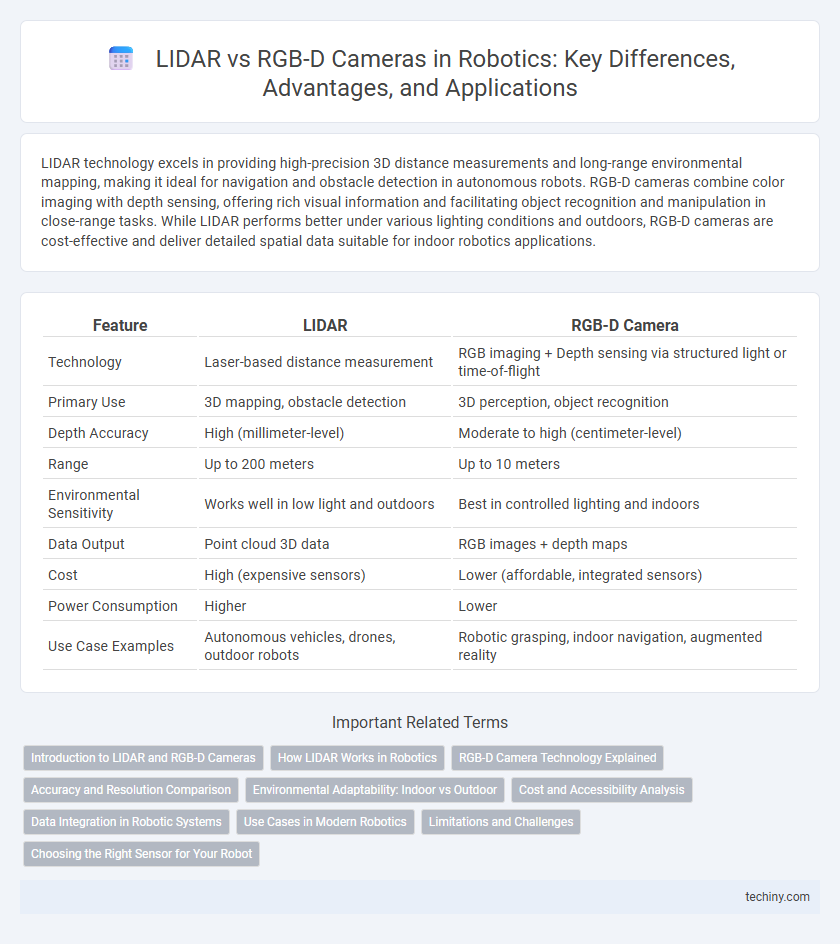LIDAR technology excels in providing high-precision 3D distance measurements and long-range environmental mapping, making it ideal for navigation and obstacle detection in autonomous robots. RGB-D cameras combine color imaging with depth sensing, offering rich visual information and facilitating object recognition and manipulation in close-range tasks. While LIDAR performs better under various lighting conditions and outdoors, RGB-D cameras are cost-effective and deliver detailed spatial data suitable for indoor robotics applications.
Table of Comparison
| Feature | LIDAR | RGB-D Camera |
|---|---|---|
| Technology | Laser-based distance measurement | RGB imaging + Depth sensing via structured light or time-of-flight |
| Primary Use | 3D mapping, obstacle detection | 3D perception, object recognition |
| Depth Accuracy | High (millimeter-level) | Moderate to high (centimeter-level) |
| Range | Up to 200 meters | Up to 10 meters |
| Environmental Sensitivity | Works well in low light and outdoors | Best in controlled lighting and indoors |
| Data Output | Point cloud 3D data | RGB images + depth maps |
| Cost | High (expensive sensors) | Lower (affordable, integrated sensors) |
| Power Consumption | Higher | Lower |
| Use Case Examples | Autonomous vehicles, drones, outdoor robots | Robotic grasping, indoor navigation, augmented reality |
Introduction to LIDAR and RGB-D Cameras
LIDAR (Light Detection and Ranging) systems use laser pulses to generate precise 3D maps by measuring the time it takes for light to return after hitting an object, enabling accurate distance and spatial data in robotics. RGB-D cameras combine traditional RGB imaging with depth sensing using infrared technology to capture color and depth information simultaneously for real-time object recognition and environment mapping. Both technologies play critical roles in robotic perception, with LIDAR excelling in long-range accuracy and RGB-D cameras providing dense, detailed visual data at shorter distances.
How LIDAR Works in Robotics
LIDAR (Light Detection and Ranging) works in robotics by emitting laser pulses that bounce off surrounding objects and return to the sensor, allowing precise distance measurements through the calculation of the time of flight. This technology generates high-resolution 3D point clouds that enable accurate mapping, obstacle detection, and navigation in real-time environments. Unlike RGB-D cameras, LIDAR is less affected by lighting conditions and provides reliable depth information at longer ranges, making it ideal for autonomous robots operating in diverse scenarios.
RGB-D Camera Technology Explained
RGB-D camera technology combines standard RGB imaging with depth sensing, enabling robots to capture precise 3D information alongside high-resolution color data. This integration allows for accurate object detection, scene segmentation, and spatial mapping essential for robotic navigation and manipulation. Unlike LIDAR, RGB-D cameras offer rich texture details and color cues, improving visual context interpretation in complex environments.
Accuracy and Resolution Comparison
LIDAR systems typically offer higher accuracy and longer range measurements with precise distance data, achieving millimeter-level resolution ideal for detailed environmental mapping. In contrast, RGB-D cameras provide dense color and depth information but generally have lower depth accuracy and shorter effective range, limited to a few meters. The resolution of RGB-D sensors is often constrained by sensor size and lighting conditions, making LIDAR the preferred choice for applications requiring robust accuracy and high-resolution 3D spatial data in robotics.
Environmental Adaptability: Indoor vs Outdoor
LIDAR systems excel in outdoor environments by providing accurate distance measurements and reliable performance under varying lighting and weather conditions. RGB-D cameras, optimized for indoor use, capture rich color and depth information but face challenges outdoors due to ambient sunlight interference and limited range. Robotics applications benefit from selecting LIDAR for robust outdoor mapping and RGB-D cameras for detailed indoor scene understanding.
Cost and Accessibility Analysis
LIDAR systems typically have higher costs ranging from $1,000 to over $10,000, limiting accessibility for budget-constrained robotics projects, whereas RGB-D cameras like the Microsoft Azure Kinect or Intel RealSense are more affordable, usually priced between $100 and $500. The widespread availability and lower price of RGB-D cameras make them a popular choice for consumer robotics and research applications requiring detailed depth perception. Cost-effective RGB-D solutions support rapid prototyping and deployment, while LIDAR's premium pricing is justified by superior range accuracy and environmental robustness in advanced autonomous robotics.
Data Integration in Robotic Systems
LIDAR sensors provide accurate distance measurements by emitting laser pulses and measuring their reflection time, creating precise 3D point clouds essential for spatial mapping. RGB-D cameras capture color images combined with depth information using infrared sensors, facilitating object recognition and environment understanding. Integrating data from LIDAR and RGB-D cameras enhances robotic perception by combining high-resolution spatial data with rich visual context, improving obstacle detection, localization, and scene interpretation in complex environments.
Use Cases in Modern Robotics
LIDAR systems excel in autonomous navigation and obstacle detection in drones and self-driving cars due to their precise distance measurements and ability to operate in varying lighting conditions. RGB-D cameras are preferred for object recognition and manipulation tasks in robotic arms and service robots, leveraging rich color and depth information to enhance scene understanding. Combining LIDAR's spatial accuracy with RGB-D cameras' semantic detail enables advanced perception systems in robots for complex environments.
Limitations and Challenges
LIDAR systems face limitations such as high cost, sensitivity to weather conditions like fog and rain, and lower resolution for capturing fine details compared to RGB-D cameras. RGB-D cameras struggle with performance in outdoor lighting conditions, limited range, and susceptibility to interference from other infrared sources, impacting accuracy. Both sensor types demand significant computational resources for data processing, which can be challenging for real-time robotic applications.
Choosing the Right Sensor for Your Robot
LIDAR sensors provide precise distance measurements using laser pulses, making them ideal for outdoor navigation and mapping in robotics. RGB-D cameras capture both color images and depth information, offering rich visual data suitable for object recognition and indoor applications. Selecting the right sensor depends on the robot's environment, required measurement accuracy, and computational resources for processing 3D data.
LIDAR vs RGB-D camera Infographic

 techiny.com
techiny.com